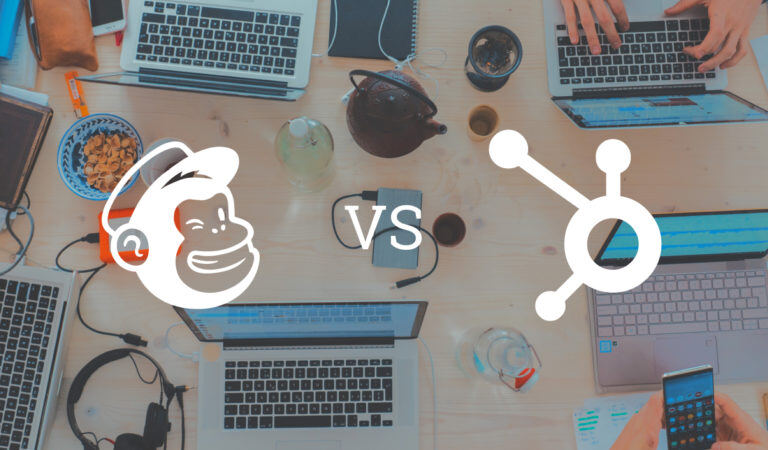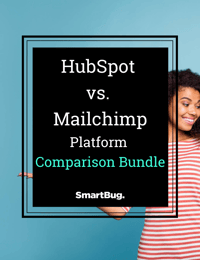
Mailchimp is a great, easy-to-use platform for email and digital marketing efforts. For numerous small businesses, it offers all of the features and functionality a marketer needs to stay in touch with their database: sending messages, list management, unsubscribe and subscription functionality, and reporting.
Mailchimp has even extended the platform to include things like pop-ups, landing pages, and a website builder. As the company continues to build out its platform’s capabilities, it fulfills more marketing needs of a small company.
But how does it measure up to HubSpot? This article will explore that question and discuss which platform is better suited for different companies.
As an Email Platform
As an email platform, both HubSpot and Mailchimp are easy to use and make sending email a breeze. Customizable templates in both tools enable marketers to brand their messages, and drag-and-drop functionality means that no HTML coding is required. Additionally, both platforms offer workflows to automate emails based on an action someone took.
When it comes to email functionality, both platforms:
- Have options for single and double opt-in subscriptions
- Manage multiple subscription types
- Handle unsubscribes
- Filter graymail
- Conduct A/B tests
- Use personalization tokens and dynamic content to customize messages
- Send emails based on the person’s timezone
- Allow you to segment and create lists of your database
- Export contacts to a spreadsheet
- Report on your email performance
There are a few email features Mailchimp offers that HubSpot does not, including:
- Analyzing the behavior of recipients and sending future emails based on the times they have clicks in the past (called “Send Time Optimization”)
- Sending out an email in “batches” so that traffic to your website is controlled
- Providing pause and edit functions in the middle of a scheduled send
- Allowing multivariate testing
Let’s now explore the features beyond email.
As Marketing Automation Software
With the addition of landing pages, pop-up forms, a website builder, social media posting, workflow automation, social media and retargeting ads, and an underlying customer relationship management (CRM) system, Mailchimp can now be called a marketing automation platform instead of just email software. In fact, I was surprised at just how much Mailchimp offers nowadays versus the software I used just a few years ago.
However, HubSpot is still in the lead when it comes to being a one-stop shop for all your marketing needs. Here are some of the things HubSpot offers that Mailchimp doesn’t:
Customizable Websites
Although Mailchimp offers the ability to create your own website, you cannot currently add custom HTML, iFrames, and merge tags to websites. This means that your options may be limited in terms of what you want the site to look like. HubSpot gives you all of those features missing in Mailchimp, as well as the ability to add merge tags (called “personalization tokens” in HubSpot) to provide a more personalized website experience.
Blogging Platform
If you are relying on Mailchimp, you’ll need an additional tool to host and publish your blog. Blog publishing is a core feature of HubSpot.
Advanced Workflows
Although both platforms have workflow engines, Mailchimp’s tool focuses primarily around automated emails. HubSpot’s workflows allow users to go beyond just email to creating tasks, updating contact fields, kicking off other workflows, and much more.
Closed Loop Reporting
Because HubSpot is an advanced marketing automation platform that offers marketing, sales, and service functionality, you can determine the return on investment (ROI) of your marketing efforts beyond just engagement metrics. Attribution reporting gives you insight into what initiatives are actually driving revenue for your organization so that you can invest effort where it matters.
For a full evaluation from both sides:
Making the Leap
When working on this blog post, I originally developed an analogy of Mailchimp being a pencil versus HubSpot being an iPad. They both enable the marketer to bring form to an idea, but HubSpot is just so much more.
After my research, I’d modify this analogy to Mailchimp being a generic smartphone versus HubSpot being an iPad. The smartphone will do most of what you need—just not everything. For many marketers, Mailchimp is similar to this analogy in that it’s perfectly sufficient, especially when considering the cost. One could assume that Mailchimp will continue to build out their platform, adding features and making the software closer to the vision of a true end-to-end marketing automation platform.
But for marketers who can convince their management team to budget in the cost, HubSpot is the full-service platform that marketers need today.

About the author
Jessica Vionas-Singer was formerly the Senior Director of Client Success at SmartBug Media where she lead a team of SmartBugs who focus on HubSpot onboarding for clients new to the system and other project-based work, oversaw new employee onboarding, and rolled out new process and procedures within the Client Services department. She fell in love with marketing at her first job at a technology company specializing in credit evaluation software. Her background includes more than 20 years of marketing experience in content creation and lead-driving tactics, online presence and blog creation, social media engagement, budgeting and project plans, webinar and trade show event management, public relations, comprehensive promotional campaigns, and analytics. Jessica has a BS in Sociology from Montana State University – Bozeman. Read more articles by Jessica Vionas-Singer.




![Grab Your HubSpot vs. Mailchimp [Platform Comparison] Bundle](https://no-cache.hubspot.com/cta/default/142915/6447750f-7675-40bf-906b-640bd63e2a2e.png)



-2.png?width=800&length=800&name=Blog%20header%20image%20(1)-2.png)